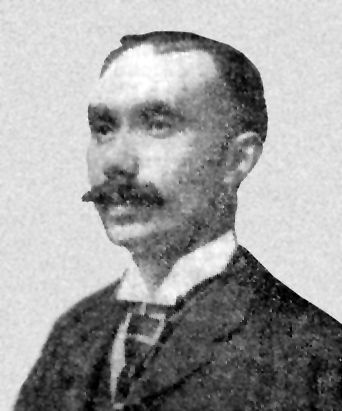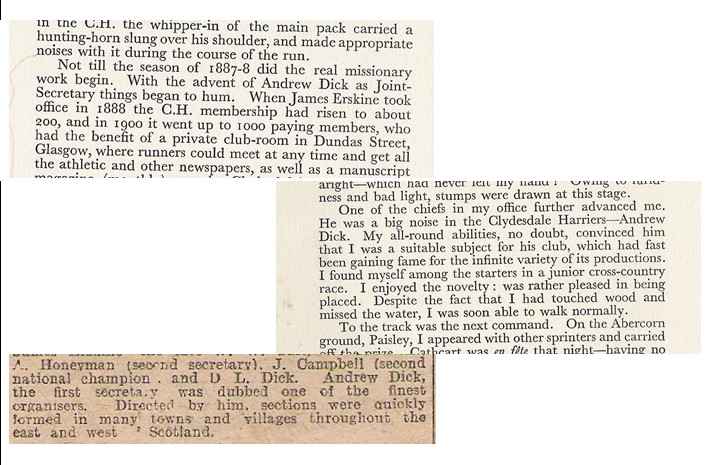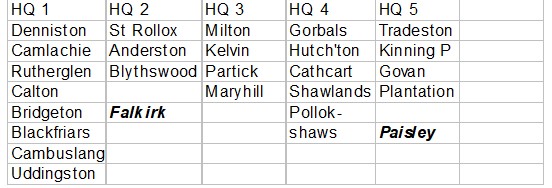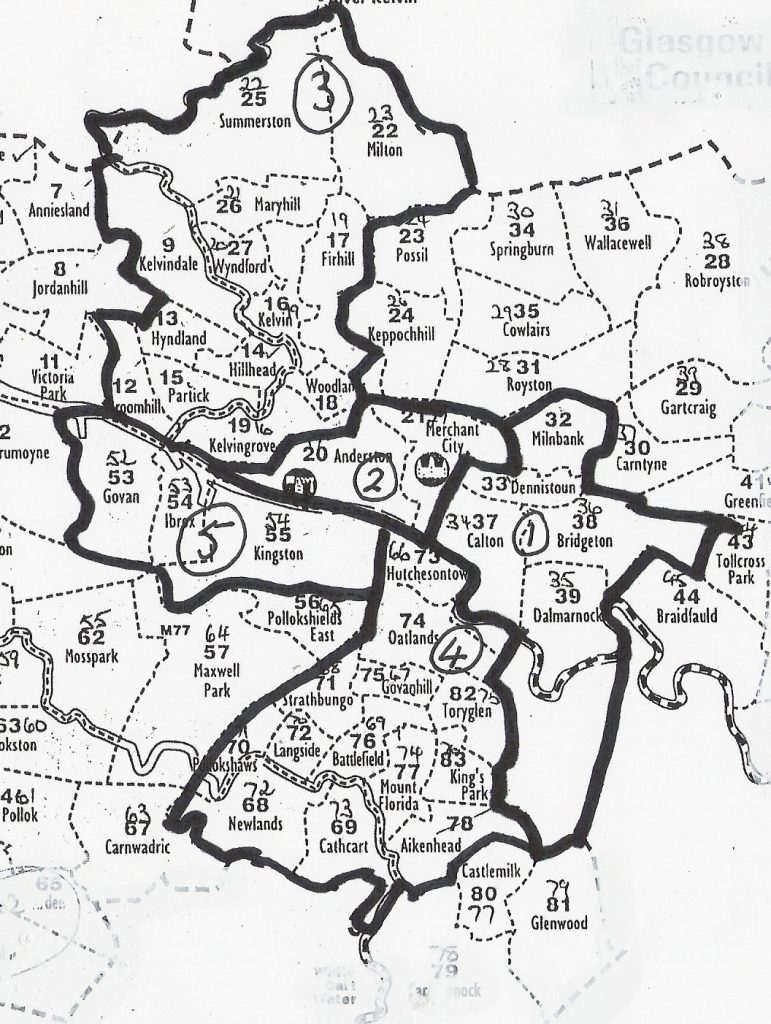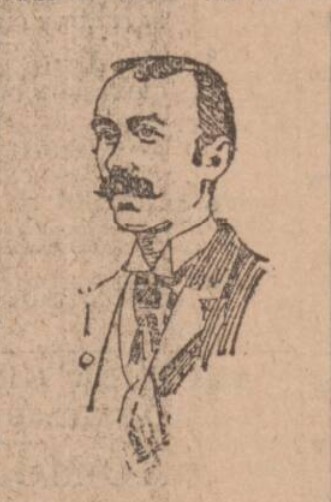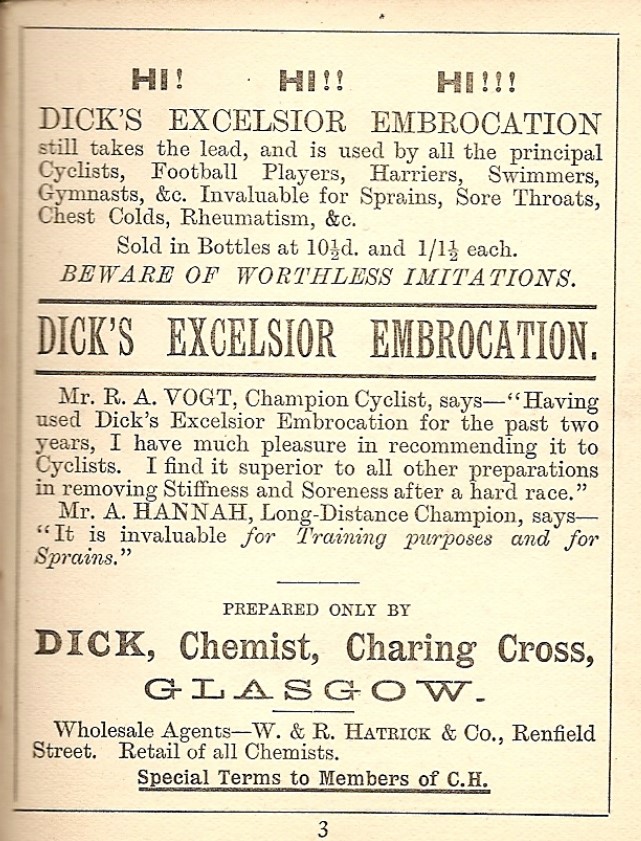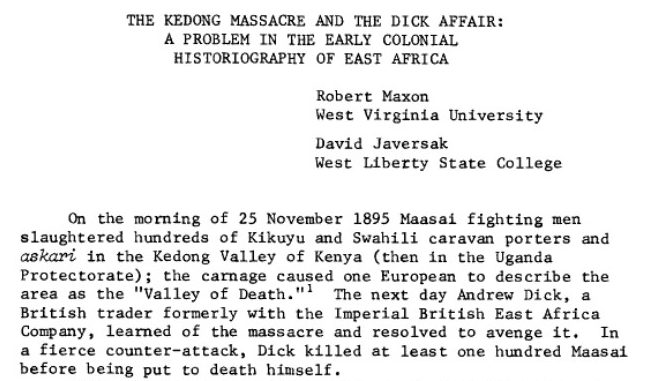ANDREW DICK
PART ONE
Andrew Dick, born in St Andrews in 1861,was probably the best Secretary the club ever had. Both comments above are from ‘Fifty Years of Athletics’ published by the SAAA in 1933: the first from Willie Maley’s chapter of reminiscences of a sports promoter and the second from George Dallas’s potted history of cross country running in Scotland. There was no doubt in anyone’s mind that he had a great influence on the club and on the sport. Unlike many of his contemporaries he had no ambitions at SAAA or SCCA level and worked solely within the club. His career also illustrates many facets of sporting life and life generally at the turn of the century.
The article by George Dallas referred to above started by saying that “cross country running in Scotland as we know it started with Clydesdale Harriers” and went on: “Not till season 1888/89 did the real missionary work begin. With the advent of Andrew Dick as Joint Secretary things began to hum. When James Erskine took office in 1888 the CH membership had risen to about 200 and in 1900 it went up to 1000 paying members who had the benefit of a private club room in Dundas Street, Glasgow where runners could get all the athletic and other papers as well as a manuscript magazine run by the club’s own members.” There was in addition a gymnastic and boxing section with premises at Garnethill and club members won world titles at cycling and boxing as well as British skating championships. The club had as well as Headquarters section sections in Ayrshire, Dunbartonshire, Falkirk, South Lanarkshire and Renfrewshire each with its own fixture list and accepting members from adjacent areas. Active recruitment was a keynote of the club at the time in its zeal to spread the gospel of athletics. In one year a gold badge was offered to the member who recruited most members in the year.
One of the real founding fathers, when Alex Macnab, the first secretary, became treasurer after the first year, Dick became secretary from the 1886/87 season. Dick was an accountant who had come from St Andrews to work with Smith & Williamson in St Vincent Street, Glasgow. He was appointed chief accountant in the British East African Company and went to Mombasa in October 1889.
In the club handbook, his address was given as 149 George Street which is right in the heart of Glasgow and he is not recorded as having raced or won any prizes in the first season. His forte was clearly in organisation. At the meeting in the Bath Hotel in December 1888 at which the Scottish Harriers Union was set up in opposition to the SCCA, it was Andrew Dick who proposed that “the Scottish Harriers Union be founded with the objectives of, first, formulating a union whereby individual interests were to be subordinated to the general interests of harriers clubs and the sport in general throughout Scotland; second, to carry out competitions on more modern and improved lines; third to endeavour to foster and encourage cross country running with as few restrictions as possible.” The scheme was carried and John Mellish elected President of the SHU. The Annual Report, almost certainly written by him said “Your committee could not see its way to supporting a body whose policy as aimed at its – the CH – dismemberment.” Clydesdale Harriers showed its intentions with a range of innovations over the next two years. Team races were decided on the top five runners and not the top six as demanded by the SCCA, the decision was taken on aggregate times rather than on the total of finishing positions, a Junior Section was set up, the London Clydesdale was set up and a football team was also set up. As secretary Andrew Dick was almost certainly involved in all these. The split was healed but as long as he was secretary club membership grew rapidly and innovation was a constant.
His real work however was done in relation to the development of sections. In an article in the Glasgow ‘Evening Times of Tuesday, October 29th, the writer under the pseudonym of ‘Pistol’ said: “Andrew Dick the first Secretary was dubbed one of the finest organisers. Directed by him sections were quickly formed in many towns and villages throughout the east and west of Scotland.” The article continues “Let it be understood that this was not a move purely and simply to further the game for the good of Clydesdale only: rather was it a step to encourage new clubs. This missionary work succeeded so well that within four years there were numerous clubs in Scotland.” A diagram of the sections that he worked so hard to set up is attached at the end. (It should be noted that there were also ambitions to set up sections for different sports after he left – the football section will be discussed in another chapter but there were even suggestions for a cycling section, a skating section and one Annual Report said that ‘A natatorial section had been mooted.’
But Andrew Dick had ambitions beyond Glasgow and was appointed to a post in Africa. He left for Mombassa in October 1889 to take up a post there with the British East Africa Company about which more will be said below.
The Handbook reported: ‘A Handsome Silver Cup has been presented by Mr Andrew Dick of Mombassa East Africa, who has so long taken a deep and kindly interest in the welfare of the Club. The Cup is named “The Dick Cup” and is to be held by the first man home in the club’s team in the Senior Cross Country Championship each year. This year it has been fitly won by Mr A Hannah, who has so consistently and honourably upheld the reputation of the club.’ Andrew Hannah went on to win it the following year and after William Robertson won it in its third year, Hannah won it again and was allowed to retain it having won it three times.
Although taking no further part in the club’s organisation he retained his membership for some time thereafter. He was the club member par excellence. This is from the ‘Scottish Referee’ article of 20th December 1895. “He was for some years the energetic secretary of Clydesdale Harriers. He also organised – in opposition to the Scottish Cross-Country Association – the Scottish Harriers Union and, in connection with which, the greatest number of Harriers championships took place. all being started at the Old Celtic Park. Mr Dick was strong in organising power, and he took a prominent part in nearly every branch of athletics. His advice was valuable and at the disposal of of anyone who approached him. He proved himself capable of any office, whether president or secretary, handicapper or starter, or judge of a race. He spared himself in no respect, and no matter how rough the day or dirty the ground, heavy the running, Andrew Dick would at once run out with the paper and lay the trail. If a pace or whip was wanted, Dick was ready, and if in the slow pack there were some weak kneed runners, Andrew plodded at their side and urged them to “keep at it” when they themselves thought it was impossible.”
The main contribution he made to the club was in the development of the various sections throughout Glasgow and indeed throughout Scotland. The extent of this work can be seen from the tabular presentation of the Sections and the areas they covered: for those interested the topic is gone into in some detail below, otherwise just jump to Part Two of the profile..
The Glasgow Headquarters area had five sections. Some sections were responsible for parts of Scotland without their own Section – eg Section 2 was also responsible for Falkirk and Section 5 for Paisley. In addition individual members outwith the main catchment were attached to one or other of the HQ Sections. The benefit of this was that there was someone responsible and accountable to the Committee for every member. The Committee had a representative whose duty was to liaise with a particular section and each section outwith Glasgow had its own area captain responsible to Committee. The network of communications both upward and downward within the club was strictly ordered.
This map shows the Glasgow Sections superimposed on a map of the present day local government electoral wards.
Sections across Scotland
The club expanded outwith the bounds of Glasgow since there was no one initially catering for the amateur athletes, and since there were many who wanted to join the new club and get involved.
Ayrshire and the whole county was covered.
Dumbartonshire which went as far as Helensburgh and Rhu
Renfrewshire which was originally just Greenock
Lanarkshire which was at one point divided into North and South.
Stirlingshire where there were pockets of members but no proper section.
Members living outwith the area were allocated to a headquarters section and groups in areas such as Falkirk and Stirling attached to a headquarters section en bloc. Each section had its own committee and they were entitled to two members attending the General Committee and the General Commttee in turn had two representatives on the section committees.
Members Resident Abroad
(These were also kept in touch with the club’s activities and the spread of countries is listed)
Australia Ceylon Demerara East Africa New Zealand Orange Free State South Africa United States of America West Africa
With two exceptions there were several members in each of these areas and not all members in South Africa were in Johannesburg for instance. The four areas of Africa listed above were separately identified in the club’s records.
When Andrew Dick left the club in October 1889 the manner of his departure tells us a lot about the times. I quote “he left for a highly lucrative and responsible post” in Mombassa in Africa. He was to be Accountant General (chief accountant) in charge of affairs for the British S.E. Company. Before he left there was a presentation to him at the inevitable smoking concert in the club rooms by Mr A McA Kennedy of a “valuable watch, a fowling piece and two six chambered revolvers.” Of the watch and fowling piece there is no doubt but as for the revolvers – the Scots Umpire gave him two, but others gave him eight, or a case of revolvers or, and this sorts things out, a case of eight revolvers. Even after he left he had his name recorded in the club handbook in the ‘Members Resident Abroad’ section for many years and in season 1893/94 he presented a trophy to the club.
PART TWO
He was personally a well-liked and popular man, of that there is no doubt. When he left from St Enoch Station for South Africa we are told that “there was a crowd of fully six hundred to wish him God Speed.” When he died in 1895, one article saying that his loss would be deplored in Zanzibar was echoed in several other reports.
After a short time in Africa in the post for which he left Glasgow, he was promoted in 1891 to assistant administrator to the company, but he resigned after only nine months to set up on his own as an independent trader. He is indeed referred in many documents as Trader Dick. He made frequent journeys into the interior for the purchase of ivory and general produce. He was well acquainted with the country and the various tribes who inhabited it. We are told by the Glasgow Herald that he was an enterprising and successful trader and in private life he was highly esteemed. In 1893 he invited his brother David L Dick, who also served as Clydesdale Harriers secretary, and “to whom he was very much attached” to South Africa. David, was also an enterprising young man and had a successful chemist’s business in Glasgow which made some of its own remedies – note the advertisement below from the club handbook for 1892 – and was endorsed by many well known personalities such as actress Ellen Terry and the sportsmen mentioned.
David unfortunately caught fever after only six months and died and then, six months later, his mother died six months later. That left Andrew in Africa and his father who lived in Glasgow. Andrew succeeded as a trader in his own firm, travelling all over the area getting to know his suppliers and customers and known for driving hard bargains.
All seemed to be going well for him until on 17th December, 1895 the following Reuter’s Telegram was printed in the Glasgow papers.
(Reuter’s Telegram)
MASAI WARRIORS KILL 1000 MEN NEAR ELDOMA
Zanzibar, Monday
According to intelligence received here, a great disaster has overtaken a caravan of 1200 men while returning through the Eldoma ravine. The caravan reached the ravine on the night of November 26th and on its way passed some Masai kraals. The Masai, believing they were about to be attacked, fell upon the caravan and killed a thousand of the men belonging to it. The survivors, accompanied by two Frenchmen , were met by a trader named Dick, who was on his way to Lake Rudolph. Marching through the Kardong Valley, the united party saw the Masai retreating with a number of cattle. They thereupon attacked the Masai and succeeded in capturing the cattle. The Masai subsequently attempted to retake the cattle, and in the fighting My Dick was killed. The two Frenchmen returned to Kikuyu.
On inquiry, a representative of Reuters agency was informed that the trader Dick, who is reported to have been killed in fighting with the Masai on the Uganda Road, is supposed to be Mr Andrew Dick, a Scotchman who had been in East Africa since 1890. Formerly he was with the British East Africa Coy’s service, but latterly had been trading on his own account. It is thought that from its size the caravan attacked in the Eldoma ravine must have been a Government caravan returning from the coast and that the Frenchmen may have been two priests from Uganda.”
That was on the Tuesday, on the Wednesday there were articles in all the papers – Herald, Evening Post, Daily Record, Greenock Telegraph with details of his career in the sport and more information about the massacre. The best article was from the ‘Scottish Referee’ and can be read at this link. The Glasgow Evening Post said of his time with Clydesdale:
“Athletes throughout the country will be pained at the news conveyed by cablegram from Africa this morning of the death of Mr Andrew Dick, so long associated with athletics generally and The Clydesdale Harriers principally. Mr Dick was one of the originators of the CH, and also promoted sections to the club thereby increasing the membership until it reached nearly a thousand strong. Mr Dick was the leading spirit in the formation of the Scottish Harriers’ Union in connection with which the greatest number of championships ever run in Scotland took place, these consisting of national, team, county and individual premier events and which were run from Celtic Park. Mr Dick travelled to England on several occasions with teams representing Scotland and was one of the principal legislators in the sport.”
The Daily Record said: “In another column reference is made to the death of Andrew Dick, of whom it can be said that no more ardent lover of cross-country running was ever identified with a Scotch club. The Clydesdale Harriers will feel the blow, as te deceased retained his personality in the club to the end. For several years back Mr Dick contributed to the prize-list of the club and in other ways demonstrated the keen interest he evinced in all its operations.”
If we go back to the massacre then we see comments such as –
In an article by Enid Dawson – Andrew Dick came to BEA in 1888 to be Chief Accountant at Mombasa for the IBEA Co. with whom he worked for 2 years. He was a tough, courageous and adventurous man and in 1890 he started off on his own as a trader using the old caravan routes into the hinterland. His bravery became legendary and the Smith Mackenzie records state that he was ‘regarded as one of the most fearless men who ever marched between the Indian Ocean and Lake Victoria’.
Ansorge – “They told me that Dick fought most fearlessly and bravely and, being an excellent shot, dropped one Masai after another. He went to pick up the shield and spear of a Masai he had just slain, when the enemy made a desperate rush, and at a critical moment Dick’s rifle jammed. He turned round to his men to get another, when a Masai rushed forward and speared him through the back, killing him on the spot. The Frenchmen killed Dick’s assailant, but fighting against overwhelming odds, they were compelled to retreat to the Fort. In a couple of days they returned to the scene of the fight in order to bury Dick. They found the body stripped naked, and buried it on the Kedong escarpment. They erected a wooden cross over the grave, which I saw still standing when I last journeyed that way. The inscription simply states, that the cross was erected by his comrades in arms to the memory of the deceased, slain by the Masai.”
Finally there is this account of the massacre and some of its consequences. The spelling is true to the original.
THE KEDONG MASSACRE
The Kedong massacre of 26th November 1895 near Naivasha town, was described by a man of European decent as a valley of death where more than 600 lives were lost in a single day, after Maasai morans on provocation butchered a caravan of Carmel transporting 1100 workers sent from Fort Smith(Kikuyu) by Mr Gilkisson the officer in charge of the station in the colonial Government to replenish food supplies to Eldama ravine station during construction of Kenya-Uganda railway.
The caravan consisted of 995 Agikuyu porters, 105 Swahili, some armed with riffles. During that time, such a huge caravan ought to have been under supervision of a European Official but for unknown reasons, it was headed by a Swahili headman described by Mr Sanders, an official in the Colonial Government too young, inexperience to command such a huge contingent.
The supplies were delivered without any incident but on the way back near Naivasha town, a quite known environs, unruly men who were part of the caravan raided a Maasai Manyatta near by kidnapped, and raped two women. Maasai elders persuaded the porters to leave in peace, and stop further provocation.
The porters perhaps emboldened by their large numbers, in a show of their might attempted to steal cattle from the Manyatta, a Moran in the homestead could not handle the agitation, speared a Swahili and was consequately shot dead.
The Maasai war cry rung the air, all the neighborhood villages assembled and mobilized morans for retaretory attack, a four mile distance was in shambles as over 600 porters lost their lives, and Maasai morans death toll stood at not less than 40 morans shot by the armed Swahili gun men.
On learning the attack Mr Andrew Dick an English business man in accompany of three Frenchmen who just arrived from Kilimanjaro in a shooting expedition, joined by a considerable armed force defied Gilkisson, the chief head of the station set for a revenge mission.
They found the Maasai morans had already moved away from the valley but rounded off hundreds of cattle grazing at the foothills of Longonot. The morans made no attempt to recapture the animals but employed a gorilla tactic, went ahead of the raiding party hiding by the bush set an ambush. The morans attack the heavily armed men with rifles, and for sometime, shooting run the air till the morans were driven back to the bush. The Morans regrouped and attacked from different direction, the Frenchmen witnessed Mr Dick being speared by one Ole Lekutit to death, though was able to kill a handful of morans, the Frenchmen were unable to retrieve Dick’s body, opted to withdraw to safety.
At the time of Dick’s death, OLanana the chief laibon and respected leader of the Maasai people, who had taken over upon death of his father the great Laibon Mbatian in 1890, was on a visit to Fort Smith along with other Maasai leaders, for a meeting with Mr John Ainsworth during the unveiling of the commission of inquiry of the incident probably the first of the Kenyan history.
During the meeting, it was agreed that the Morans were justified, on reacting to provocation from the porters and company. Dick’s action was deemed unwarranted and had no right to avenge. It was decided that the Maasai cattle taken should not be returned but act as a fine for the lives lost, the same were distributed among the relatives of the people who died in the massacre mostly from the Agikuyu porters. It’s important to note that, the Maasai who died in the ordeal were not compensated by their own.
In a show of solidarity and empathy, the Agikuyu elders conceded that the Maasai morans were not to be blamed. This piece of history leaves us with sad memories that by today’s standards would have made headlines in the international media.
There is a little more on this incident at A massacre and a friendship, Kedong massacre (1895) – HapaKenya which corroborates the above
Andrew Dick died on 27th November 1895 and the fixture list decided at the start of the 1895/96 season had decreed that the race for the Dick Cup would be held on the 25th January 1896 – just two months after his death.
Finally, it is only right that the assistance of John Mackay with Part Two is acknowledged.
